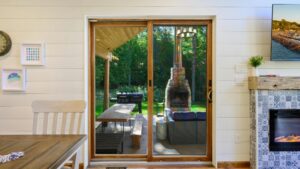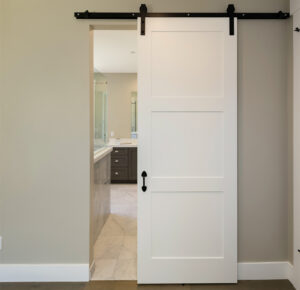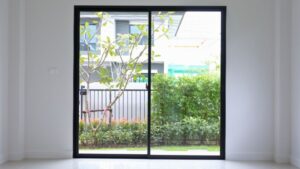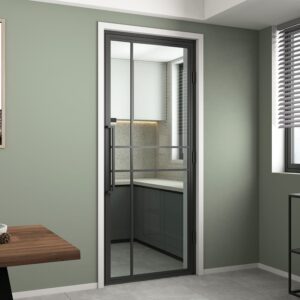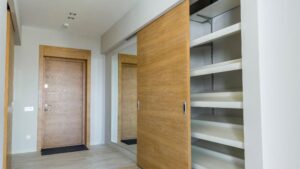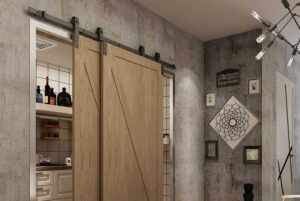When it comes to selecting the perfect door for your home, both pocket doors and barn doors offer unique design elements and functionality. This article will help you understand the difference between these two popular door styles.

Key Takeaways
- Barn doors may leave a gap when closed, affecting privacy, whereas pocket doors close flush with the wall for better privacy.
- Both door types can be made from a variety of materials, including wood, glass, and aluminum.
- Barn doors are generally easier to install and offer versatility in style, but may require more wall space and not seal completely.
- Pocket doors, while space-efficient and sleek, can be more challenging to install and may come with higher maintenance needs.
Understanding Pocket and Barn Doors
To help you make a more informed decision on the right door for your needs, we will provide a brief overview of barn doors and pocket doors in this section.
What is a Barn Door?
A barn door is a type of door that slides along a horizontal track mounted on the wall, giving your room a rustic appearance.
These doors can be made from various materials but are commonly found as wooden doors, making them an excellent choice for adding warmth to your space. Barn doors come in various styles, ranging from traditional designs to more contemporary and modern looks.
What is a Pocket Door?
A pocket door is a type of sliding door that disappears into a compartment inside the wall when it’s fully open.
This type of door offers a space-saving solution and helps to keep your interiors clutter-free. If you have a small space or need to make the most of what’s available, pocket doors are an excellent choice.
You may find that pocket doors come in various styles, making it easy to find one that fits your home’s design. They can be traditional, modern, or somewhere in between.
The primary benefit of using a pocket door is that it doesn’t take up any floor space, unlike a regular swinging door. This means you can place furniture and other items close to the door without interfering with the room’s functionality.
Key Differences Between Barn Doors and Pocket Doors
Design and Appearance
When comparing these two kinds of doors, the design and appearance are distinguishing factors. Pocket doors are designed to slide into a compartment within the wall cavity, making them unobtrusive and perfect for small spaces. Barn doors, on the other hand, slide across the wall on a visible track, creating a more decorative and rustic look.
Functionality
Functionality-wise, both pocket doors and barn doors excel at providing space-saving solutions. Since they don’t swing out when opened, they are ideal for rooms with limited floor space, such as closets or dining rooms. However, pocket doors are more easily concealed when open, granting a tidier appearance.
Aesthetics
The aesthetics of pocket and barn doors cater to different tastes. Pocket doors typically offer clean lines and a minimalist design, seamlessly blending with your home’s architecture. Barn doors, conversely, add character and a rustic charm, acting as a visual focal point and enhancing the overall decor.
Privacy
In terms of privacy, pocket doors have the advantage. Since they close flush with the wall, they provide a complete seal, preventing sound and light from passing through. Barn doors, however, may leave a small gap between the door and the wall, which can affect privacy in certain situations.
Costs
- Door Pricing Breakdown
Barn doors, including their tracking hardware, typically cost between $250 and $2,500. The material, whether wood, metal, MDF, or vinyl, dictates the price. In contrast, pocket doors range from $60 to $1,000 based on size, material, and design. Additional hardware might add another $100 to $350.
- Installation Expenses
Pocket door installations are typically handled by professionals due to the complexities involved and can change a home’s structure. For new constructions, installation is $100 to $500, but for existing walls, it jumps to $1,000 to $2,500. Installing a barn door on an existing wall can range from $100 to $300.
When choosing between the two, consider that pocket doors usually have lower material costs but higher installation fees. Conversely, barn doors might be pricier in materials for specific styles but could be cheaper to set up, especially for DIY enthusiasts.
Materials and Durability
- Pocket Door Materials
Pocket doors are typically made of either solid wood or a combination of wood and glass. Solid wood doors offer better durability and can be refinished over time if they show signs of wear. Some pocket doors are also available in aluminum, which is lightweight, corrosion-resistant, and low maintenance. However, aluminum doors may not provide the same level of insulation or acoustic control as their wood counterparts.
Wooden pocket doors can be made from various types of wood, including pine, oak, and cherry. Each wood type has its own pros and cons regarding durability, maintenance, and appearance. Choosing the right wood depends on your personal preferences and your home’s style.
- Barn Door Materials
Barn doors, like pocket doors, are generally made of wood, though other materials like glass and metal are also used in some designs. Wooden barn doors can be made from the same types of wood as pocket doors – pine, oak, cherry, and more. Each type of wood carries its own benefits and drawbacks regarding durability and maintenance.
Aluminum barn doors are also available, offering similar benefits as aluminum pocket doors: they are lightweight, corrosion-resistant, and low maintenance. However, these doors may not provide the same level of insulation or sound control as wooden options.
Pros and Cons
Advantages of Pocket Doors
Pocket doors have several advantages that may cater to your needs. One of their main benefits, as we mentioned many times before, is their space-saving design. Unlike swinging doors, they slide into a compartment in the wall, freeing up floor space and ensuring that your room has a clean, unobtrusive look.
Another advantage of pocket doors is their accessibility. They are easy to open and close with a gentle push or pull, making them suitable for all users, including people with mobility challenges.
Additionally, pocket doors offer a wide range of styles, making it easy to find one that complements your home’s aesthetic. Since they don’t obstruct the view of walls or artwork when open, you can maintain your room’s decor.
Disadvantages of Pocket Doors
However, pocket doors come with a few drawbacks. They can be difficult to install and may require professional assistance, particularly if you need to create a new wall cavity or alter the existing structure. This aspect can result in higher costs and a more time-consuming project, especially if a load-bearing wall is involved.
Keep in mind that pocket doors may not provide the best soundproofing or complete privacy in some cases. If acoustic control or sealing off a room entirely is crucial for you, be sure to research thoroughly before deciding on a pocket door for your space.
Maintenance can also be a bit demanding for pocket doors, as problems with the hardware or track might cause them to come off, not shut properly, or need regular adjustments.
Advantages of Barn Doors
Barn doors offer some attractive features as well. For starters, they are relatively easy to install, as they typically require minimal changes to your existing wall structure. Barn door hardware, such as the sliding track, is usually more straightforward and accessible for maintenance.
Style-wise, barn doors also come in various options, making it simple to find one that matches your aesthetic preferences. They can even serve as a statement piece in your room, adding a rustic or industrial touch to the space.
Disadvantages of Barn Doors
One of the primary drawbacks of barn doors is that they require sufficient wall space to slide open. If your room lacks adequate space, a barn door might cover windows, artwork, or other architectural elements, limiting your design choices.
Lastly, it’s essential to consider that barn doors may not provide the same level of privacy or insulation as pocket doors since they don’t completely seal the opening or fit within a wall cavity. This factor might make them less suitable for spaces where complete privacy is desired.
Installation Guide
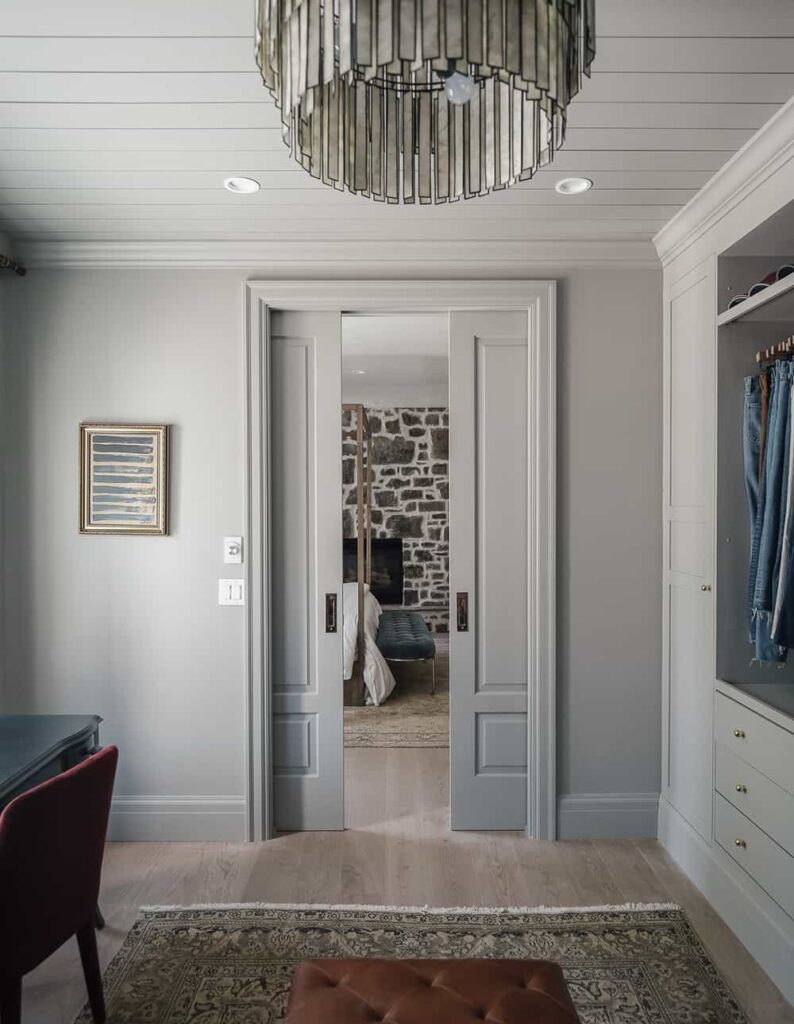
In this friendly guide, we will walk you through the installation process for both pocket doors and barn doors. These space-saving sliding doors can be a great addition to your home, but proper installation is key.
Pocket Door Installation
When installing a pocket door, first determine its location. Consider the position of electrical outlets and wiring to avoid any complications. Determine if the existing wall can accommodate a pocket door or if a retrofit is required.
Begin by removing the existing door and door jamb if necessary. Prepare the pocket door hardware, which usually includes a track, rollers, and hidden hardware. Here are some steps to follow:
- Create an opening in the wall: Follow the manufacturer’s instructions to create the right size opening in your wall to accommodate the pocket doorframe.
- Install the track: Carefully position and secure the track at the top of the opening, ensuring it is level.
- Insert the doorframe: Place the doorframe into the opening and make sure it is square and plumb.
- Attach the rollers: Following the manufacturer’s guidelines, attach the rollers to the top of the door, ensuring they are properly aligned.
- Hang the door: Carefully lift the door and insert the rollers into the track. Test the door’s smooth sliding motion before moving on to the next step.
- Install the door jamb and trim: Complete the installation by attaching the door jamb and trim to the opening.
It is highly recommended to hire a contractor for pocket door installation, as it can be a complex process, especially when working with existing walls.
Barn Door Installation
Installing a barn door is generally easier than a pocket door, as it does not require modifying the existing wall. First, determine the location of your door and ensure there are no electrical outlets or wiring in the area where the hardware will be mounted. Here’s an outline of the installation process:
- Measure the door size: It’s crucial to get accurate measurements of your door size to ensure it will completely cover the opening and the correct track length.
- Install the track: Carefully position and secure the track above the door opening, following the manufacturer’s instructions. Make sure it is level and aligned with the center of the opening.
- Attach the rollers to the door: Depending on the style of door and hardware chosen, the rollers will either be visible or hidden. Follow the manufacturer’s guidelines for proper roller installation.
- Hang the door: Gently lift the door and place the rollers into the track. Test the sliding motion to ensure smooth operation.
- Install door stops and guides: Attach the door stops and floor guide provided with the hardware to prevent the door from coming off the track and to keep it properly aligned.
While a barn door installation is easier than a pocket door, it is still a good idea to hire a professional contractor or consult one if you are unsure about any part of the process.
Maintaining Your Doors
In this section, we’ll discuss maintaining both pocket and barn doors to ensure they remain functional and appealing. We’ll go over the specific maintenance needs of each type, helping you understand the procedures and considerations.
Pocket Door Maintenance
Pocket doors are an excellent choice for saving space and maintaining a seamless appearance in your home. To keep your pocket door functioning smoothly, it’s essential to focus on the quality of the track system. Regularly inspect the track for debris and alignment issues. Remove any obstructions and realign the track as needed.
To further prolong the lifespan of your pocket door, it’s crucial to lubricate the track and rollers periodically. Use a silicone-based lubricant, as it won’t attract dust or dirt and helps decrease wear and tear. Although pocket doors can be budget-friendly, their installation and maintenance costs may be higher compared to barn doors.
Barn Door Maintenance
Barn doors offer a stylish, functional, and easily accessible solution for your home. They require comparatively less wall space and can be a more budget-friendly option. Maintain your sliding barn door by first ensuring the track system’s quality. Check that the track and hardware are securely attached to the wall and that the door slides smoothly.
Regular lubrication is also essential for barn doors. Opt for a silicone-based lubricant to keep the door’s movement smooth and quiet. Inspect and tighten the rollers and stops as needed, and address any gaps between the door and the wall to maintain privacy and noise control.
In summary, maintaining both pocket and barn doors involves periodic inspections, track alignment, and lubrication. By following these steps, you’ll ensure your doors continue to operate smoothly and add value to your home.
Choosing the Right Door for Specific Areas
When deciding on the perfect door for different areas of your home, it’s essential to consider both pocket doors and barn doors. Each option offers different benefits and drawbacks, depending on the specific space and your aesthetic preferences.
Pocket Doors for Small Areas
Pocket doors are excellent for small areas in your home like bathrooms, closets, and other tight spaces. These doors slide neatly into a compartment within the wall, providing an unobtrusive solution that takes up minimal space. With their space-saving abilities, pocket doors allow you to comfortably maneuver in smaller rooms and prevent interference with furniture or artwork on the walls.
In addition, pocket doors are a practical solution for shelving units, as they don’t swing outward and create extra room for your shelves. They can also lend a sleek, modern look to small areas without compromising your desired style or theme.
Barn Doors for Artistic Appeal
Barn doors, on the other hand, add an artistic touch to any room while still providing space-saving benefits. They are mounted on a track and slide along the wall, enhancing the appearance of the room and drawing attention to the door itself. Because they don’t slide into a wall like pocket doors, barn doors offer an opportunity to showcase your unique taste in design.
Ideal for rooms where you want to make a statement, barn doors can be used as a focal point for displaying artwork or interesting architectural features. Customize your barn door with different colors, materials, or hardware to create a look that reflects your personality and complements your décor.
When choosing between a pocket door and a barn door, consider the specific space and your design vision. Pocket doors offer an understated, space-saving option for small areas and tidy environments, while barn doors add a bold, artistic touch to your home without sacrificing functionality.
FAQ
How do pocket door and barn door installations differ?
Pocket door installations typically require creating a compartment within your wall for the door to slide into. This can make installation more complicated and time-consuming. Barn door installations involve attaching a track above the door frame and hanging the door on rollers, which is generally simpler and easier.
Can I use a barn door to replace a pocket door?
Yes, you can replace a pocket door with a barn door, but it will require some modifications. You will need to remove the pocket door and seal the wall compartment, then install a track above the door opening for the barn door. Keep in mind that a barn door will cover some wall space, unlike a pocket door.
Which door type saves more space: pocket or barn door?
Both pocket doors and barn doors are designed to save space. However, pocket doors save more space because they slide into a compartment inside the wall, while barn doors slide along the wall, consuming some wall space.
Are there any specific design styles that work better with pocket or barn doors?
Pocket doors can suit many home styles due to their concealed nature, while barn doors can add character and charm, making them more suitable for rustic or industrial settings. Ultimately, the design style that works best for you will depend on your personal taste and your home’s aesthetic.

